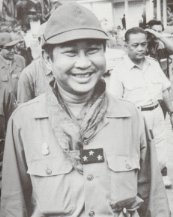Cambodia 1970-73

Lon Nol, premier, then president, of Cambodia
Cambodia had been a successfully neutral state long after South Vietnam and Laos were plunged into war. Up through the end of the 1960s, the country's ruler, Prince Norodom Sihanouk, had managed to keep Cambodia at arm's length from the combatants. Although, as we saw in chapter three of the book, the U.S. was hostile to Sihanouk, intriguing against him and training rightist forces and Vietnamese ethnic Cambodians in Thailand and South Vietnam , most fighting involving U.S. troops or planes stayed on the Vietnamese side of the border. Similarly, although Cambodia was a transit zone through which supplies reached communist forces in South Vietnam, the North Vietnamese kept a relatively low profile, keeping to themselves and confining their sanctuaries to a fairly limited area. There was a tiny communist insurgency, but it posed no threat to Sihanouk's regime.
This state of grace ended when Nixon, seeking a way to pressure North Vietnam (see the discussions about that country in the book, as well as the North Vietnamese bombing case elsewhere on this website), acceded to long-standing military demands and, with some enthusiasm, instituted a highly secret bombing campaign of the North Vietnamese facilities in Cambodia . The only effect of the bombing was to push the North Vietnamese away from the border and closer to the country's center, where they came in contact with greater numbers of Cambodians. Sihanouk, weakened politically from his inability to end the North Vietnamese presence, was eventually overthrown by the military (the nature and extent of the U.S. role remains unclear), which had two profound effects: Sihanouk threw his lot in with the communist insurgents, and the country's new leader, Lon Nol, prepared to confront the North Vietnamese militarily (he also encouraged massacres of ethnic Vietnamese). Almost immediately, Nixon rewarded the new Cambodian government with military aid and flew in the anti-Sihanouk forces which had been trained by the U.S. over the preceding years; the South Vietnamese also began crossing the border in search of communist units. The North Vietnamese, caught between Cambodian and South Vietnamese forces, began moving away from the border and toward the country's capital, Phnom Penh . Nixon reacted to this by ordering a U.S. and South Vietnamese invasion of the Cambodian border region which, if not helpful to the Lon Nol regime (in fact, it drove the North Vietnamese closer still to Phnom Penh and for this reason was opposed by Lon Nol) would, it was thought, eliminate a source of pressure on the U.S. effort in South Vietnam. It gained at most three months, led to outraged protests in the U.S. and to the first successful congressional efforts to restrict the war, and, when Nixon bowed to the opposition and terminated the invasion after two months, left the Cambodian regime in a militarily dire situation.
The U.S. was now faced with the problem of how to support a client which in six months had “lost control of almost half” its territory and was “incapable of coping with the enemy on its own.” To build up a competent Cambodian military through extensive U.S. aid was fine, but would take time; and although South Vietnamese and Thai forces (also Indonesian advisers) could be and were called on, it rapidly became clear that there were too few of them to make much of a difference. No other proxies existed: the U.S.-trained exile forces had already been chewed up, and Cambodia did not contain large enough non-Khmer ethnic groups for a Hmong-style policy to be pursued. This left the air power component of the proxy strategy initiated several months earlier, something which Nixon had already insisted on before the invasion had ended. The order that went out was to resort to “the most aggressive U.S. and [South Vietnamese] air campaign in Cambodia which is feasible”; bombing should occur “in any situation which involves a serious threat to major Cambodian positions.” Soon, an entire panoply of missions were being carried out, including “Spooky” and “Shadow” gun ship attacks, fighter support of ground troops and river convoys, and B-52 bombings. (There also continued to be bombing in the eastern part of the country against North Vietnamese infiltration.) As the Cambodian insurgents grew in numbers, these operations intensified correspondingly. In 1973, when (temporary) peace agreements were reached in South Vietnam and Laos , almost all the U.S. air assets were shifted to Cambodia . From then until the summer, when Congress finally shut down the air war in Cambodia, there were over 1,000 tactical sorties a week; during the final six months, over a quarter of a million tons of bombs were dropped (this was over half again as much as the U.S. dropped on Japan during all of World War II). This killed some 16,000 insurgents and kept them from taking power for another twenty months. 1
1) VSSG Working Group, NSSM 99, “US Strategy Options for Cambodia,” Draft, 13 September 1970, 6, 11; National Security Decision Memorandum 89, “Cambodia Strategy,” 26 October 1970; both ProQuest (2005); Joint Chiefs of Staff to Abrams, Ivy Tree, 2835, 17 June 1970, quoted in Shawcross (1979: 214); U.S. Congress, Senate (1970: 4); U.S. Congress, Senate (1973a); Elder (1973); Hersh (1983: chs. 5, 15-6); Bundy (1998: 71-5, 145-64, 219-24, 385-99, 490-4); Clymer (2004: chs. 1-2). The one indispensable reference, at least until such time as the archives are fully opened, is Shawcross's Sideshow (1979), which is based on an astonishing number of documents, as well as interviews.
